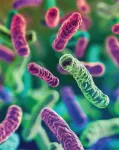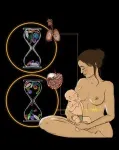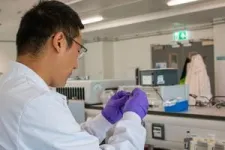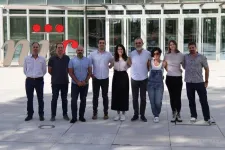(Press-News.org) Human breast milk regulates a baby’s mix of microbes, or microbiome, during the infant’s first year of life. This in turn lowers the child’s risk of developing asthma, a new study shows.
Led by researchers at NYU Langone Health and the University of Manitoba, the study results showed that breastfeeding beyond three months supports the gradual maturation of the microbiome in the infant’s digestive system and nasal cavity, the upper part of the respiratory tract. Conversely, stopping breastfeeding earlier than three months disrupts the paced development of the microbiome and was linked to a higher risk of preschool asthma.
Some components in breast milk, such as complex sugars called human milk oligosaccharides, can only be broken down with the help of certain microbes. This provides a competitive advantage to microbes capable of digesting these sugars. By contrast, infants who are weaned earlier than three months from breast milk and who then rely solely on formula feeding, become home to a different set of microbes — ones that will help the infant to digest the components in formula. While many of these microbes that thrive on formula do eventually end up in all babies, the researchers showed that their early arrival is linked to an increased risk of asthma.
“Just as a pacemaker regulates the rhythm of the heart, breastfeeding and human milk set the pace and sequence for microbial colonization in the infant’s gut and nasal cavity, ensuring that this process occurs in an orderly and timely manner,” said study co-senior investigator and computational biologist Liat Shenhav, PhD. “Healthy microbiome development is not only about having the right microbes. They also need to arrive in the right order at the right time,” said Shenhav, an assistant professor at NYU Grossman School of Medicine, its Institute for Systems Genetics, and the School’s Department of Microbiology.
For the study, Shenhav, who is also an assistant professor at NYU’s Courant Institute of Mathematical Sciences, worked in collaboration with study co-senior investigator Meghan Azad, PhD, director of the Manitoba Interdisciplinary Lactation Center, and a professor of pediatrics and child health, at the University of Manitoba.
Another key study finding was that the bacterial species called Ruminococcus gnavus appeared much sooner in the guts of children who were weaned early from breast milk than in those of children who were exclusively breastfed. The bacterium is known to be involved in the production of molecules called short-chain fatty acids, and the formation and breakdown of the amino acid tryptophan. Both tryptophan and its metabolites have been linked to immune system regulation and disruption in previous research, including an increased risk of asthma. The study authors noted that beyond aiding in digestion, an infant’s microbiome plays a crucial role in the immune system’s development.
Publishing in the journal Cell online Sept. 19, the study tracked the ebb and flow of microbes in the guts and noses of infants during the first year of life, as well as details on breastfeeding and the composition of their mothers’ milk. All the children and their mothers were participating in the CHILD Cohort Study, a long-term research project that has been studying the same 3,500 Canadian children at different stages of life from the womb well into adolescence.
The data provided by the CHILD Cohort Study enabled researchers to detangle the impact of breastfeeding on an infant’s microbiome from a range of other environmental factors, including prenatal smoke exposure, antibiotics, and the mother’s asthma history.
Even when these factors were accounted for, they found that breastfeeding duration remained a powerful determinant for the child’s microbial makeup over time. They also used these microbial dynamics and data on milk components to train a machine-learning model that accurately predicted asthma years in advance. Finally, they created a statistical model to learn causal relationships, which showed that the primary way breastfeeding reduces asthma risk is through shaping the infant’s microbiome.
“The algorithms we developed provide valuable insights into microbial dynamics during an infant’s first year of life and how these microbes interacted with the infant,” said Shenhav. “These insights allowed us to move beyond identifying associations, enhancing our ability to make predictions and explore causal relationships.
“Our research highlights the profound impact of breastfeeding on the infant microbiome and breastfeeding’s essential role in supporting respiratory health. By uncovering the mechanisms behind the protective effects of breast milk, as demonstrated in this study, we aim to inform national guidelines on breastfeeding and weaning from breast milk in a data-driven manner.
“With further research, our findings could also contribute to developing strategies to prevent asthma in children who cannot be breastfed for at least three months,” she added.
Funding support for the study was provided by National Institutes of Health grant DP2AI185753. Additional funding was provided by Genome British Columbia (274CHI), the University of British Columbia, CIHR CGS-D, the Canadian Institute for Advanced Research’s Humans and the Microbiome program, and the Canada Research Chair Program. Study participants were all volunteers from families involved in the CHILD Cohort Study, which was initially funded by the Canadian Institute of Health Research (CIHR) and AllerGen NCE.
Besides Shenhav and Azad, other study co-senior investigators are Padmaja Subbarao at the University of Toronto and Michael Surrette at McMaster University in Hamilton.
Other study co-investigators include co-first author Kelsey Fehr and co-author Elinor Simons, both at the University of Manitoba; and co-authors Myrtha Reyna, Ruixue Dai, Theo Moraes, and Vanessa Breton at the University of Toronto; Charisse Petersen, Darlene Dai, and Stuart Turvey at the University of British Columbia; Laura Rossi and Marek Smieja at McMaster University; Michael A. Silverman and Maayan Levy at the University of Pennsylvania in Philadelphia; Lars Bode at the University of California, San Diego; Catherine Field and Piush Mandhane at the University of Alberta; and Jean S. Marshall from Dalhousie University in Halifax.
Media Inquiries:
David March
212-404-3528
david.march@nyulangone.org
STUDY DOI
10.1016/j.cell.2024.07.022
STUDY LINK WILL BECOME ACTIVE AFTER EMBARGO LIFTS
https://cell.com/cell/fulltext/S0092-8674(24)00782-7
AN IMAGE IS ALSO AVAILABLE UPON REQUEST
Caption: Electron microscope image of bacteria from an infant’s gut
Credit: Courtesy of Liat Shenhav, NYU Langone Health
END
Breastfeeding is crucial to shaping infant’s microbes and promoting lung health
2024-09-19
ELSE PRESS RELEASES FROM THIS DATE:
Scientists at the CNIC discover an unexpected involvement of sodium transport in mitochondrial energy generation
2024-09-19
The GENOXPHOS (Functional Genetics of the Oxidative Phosphorylation System) group at the Centro Nacional de Investigaciones Cardiovasculares (CNIC) has discovered a crucial role of sodium in the generation of cellular energy. The study, led by GENOPHOS group leader Dr. José Antonio Enríquez, also involved the participation of scientists from the Complutense University of Madrid, the Biomedical Research Institute at Hospital Doce de Octubre, the David Geffen School of Medicine at UCLA, and the Spanish research networks on frailty and healthy aging (CIBERFES) ...
Origami paper sensors could help early detection of infectious diseases in new simple, low-cost test
2024-09-19
Researchers at Cranfield University have developed an innovative new method for identifying biomarkers in wastewater using origami-paper sensors, enabling the tracking of infectious diseases using the camera in a mobile phone. The new test device is low-cost and fast and could dramatically change how public health measures are directed in any future pandemics.
Wastewater a key way to track infections
Testing wastewater is one of the primary ways to assess the prevalence of infectious diseases in populations. Researchers take samples from various ...
Safety of the seasonal influenza vaccine in 2 successive pregnancies
2024-09-19
About The Study: In this large cohort study of successive pregnancies, influenza vaccination was not associated with increased risk of adverse perinatal outcomes, irrespective of interpregnancy interval and vaccine type. Findings support recommendations to vaccinate pregnant people or those who might be pregnant during the influenza season.
Corresponding Author: To contact the corresponding author, Darios Getahun, MD, PhD, MPH, email darios.t.getahun@kp.org.
To access the embargoed study: Visit our For The Media website at this link https://media.jamanetwork.com/
(doi:10.1001/jamanetworkopen.2024.34857)
Editor’s ...
Preconception and early-pregnancy BMI in women and men, time to pregnancy, and risk of miscarriage
2024-09-19
About The Study: The findings of this study suggest that optimizing body mass index (BMI) in women and men from the preconception period onward might be an important strategy to improve fertility and reduce the risk of miscarriage.
Corresponding Author: To contact the corresponding author, Vincent W. V. Jaddoe, MD, PhD, email v.jaddoe@erasmusmc.nl.
To access the embargoed study: Visit our For The Media website at this link https://media.jamanetwork.com/
(doi:10.1001/jamanetworkopen.2024.36157)
Editor’s Note: Please see the article for additional information, including other authors, author contributions and affiliations, conflict ...
Samples from Huanan Seafood Market provide further evidence of COVID-19 animal origins
2024-09-19
A new international study provides a shortlist of the wildlife species present at the market from which SARS-CoV-2, the virus responsible for the COVID-19 pandemic, most likely arose in late 2019.
The study, published Thursday in the journal Cell, is based on an analysis of genetic data released by the Chinese Center for Disease Control and Prevention. The data comes from more than 800 samples collected in and around the Huanan Seafood Wholesale market in Wuhan, China, beginning on Jan. 1, 2020, and from viral genomes from early COVID-19 patients.
"This may be the last big, new set of data directly from ...
City of Hope vaccine experts report positive results on Phase 1 trial of personalized vaccine for lymphoplasmacytic lymphoma
2024-09-19
LOS ANGELES — A team of researchers from City of Hope®, one of the largest and most advanced cancer research and treatment organizations in the U.S., and The University of Texas M.D. Anderson Cancer Center, have reported safety and efficacy results from a Phase 1 trial that featured a personalized vaccine to treat lymphoplasmacytic lymphoma, a rare and slow-growing type of blood cancer, according to a study published recently in Nature Communications.
The current approach to lymphoplasmacytic lymphoma care is active surveillance of a patient’s possible symptoms. ...
Global assessment: How to make climate adaptation a success
2024-09-19
Climate change is forcing people to adapt to changing environmental conditions. But what really makes the difference is how they do it. The recently published Hamburg Climate Futures Outlook 2024 by 73 authors shows that, in the long run, only sustainable adaptation can succeed. This global assessment by University of Hamburg’s Cluster of Excellence Climate, Climatic Change, and Society (CLICCS) also provides practical recommendations.
“Successfully adapting to the impacts of climate change is just as difficult and challenging as reducing emissions of every kind,” says Anita Engels, Professor of Sociology ...
The African Engineering and Technology Network signs eighth university partner
2024-09-19
Carnegie Mellon University Africa announced today that the African Engineering and Technology Network (Afretec) has signed its eighth university partner, Al Akhawayn University. The network, launched in 2022, provides a vehicle for technology-focused universities in Africa to engage in deep collaboration to drive inclusive digital growth, create technology development and job growth, and shape policy change.
Afretec Network members span the entire continent and include Carnegie Mellon University Africa, the American University in Cairo, Université Cheikh ...
Researchers awarded $1.14M to use artificial intelligence to determine best rectal cancer treatment strategy
2024-09-19
CLEVELAND—With a new four-year, $1.14 million grant from the U.S. Department of Veterans Affairs, researchers at Case Western Reserve University and the Louis Stokes Cleveland VA Medical Center, will use artificial intelligence (AI) to determine the best personalized treatment for Veterans with rectal cancer.
Colorectal cancers are the third-most common type of cancer in military personnel, affecting up to 8% of Veterans and 5% of active-duty Service members, according to the American Cancer Society (ACS). More than 152,000 patients in the United States will be diagnosed with colorectal cancer in 2024, with more than 46,000 localized ...
A new ventilator-on-a-chip model to study lung damage
2024-09-19
COLUMBUS, Ohio – For the first time, scientists are able to directly compare the different kinds of injury that mechanical ventilation causes to cells in the lungs.
In a new study, using a ventilator-on-a-chip model developed at The Ohio State University, researchers found that shear stress from the collapse and reopening of the air sacs is the most injurious type of damage.
This miniature “organ-on-a-chip” model simulates not only lung injury during mechanical ventilation, but also repair and recovery, in human-derived cells in real time, said co-lead author ...








